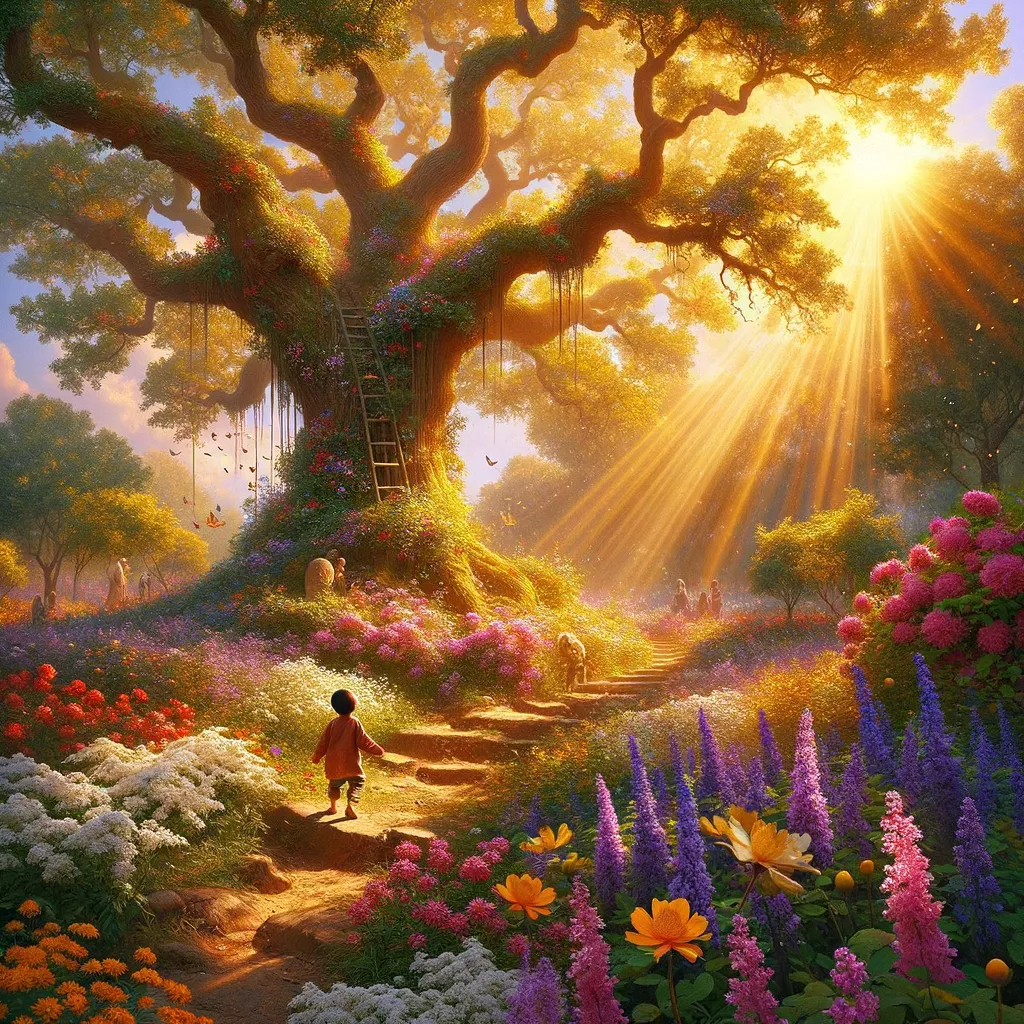In a Garden of Memories: Discovering Life’s Hidden Truths
In a sun-drenched garden, vibrant with the laughter of children and the sweet scent of jasmine, a young soul discovers the transformative power of nature. Climbing a majestic oak tree, the child feels an exhilarating connection to the world, realizing that each moment of joy intertwines with a deeper sense of belonging. Yet, as time passes, the garden morphs from a sanctuary of innocence to a poignant reminder of loss, echoing the complexities of life itself. Revisiting the space years later, the wild beauty that has reclaimed the garden reveals a surprising truth: even in chaos, life flourishes, and identity evolves. Embracing this revelation, the child understands that memories are not static but dynamic threads that weave the rich tapestry of existence, shaping who we are destined to become.
In the memory of March 17, 2000, I find myself standing in a sun-drenched garden, a kaleidoscope of colors swirling around me. The air is thick with the scent of blooming jasmine, and the laughter of children dances like the petals caught in a gentle breeze. My small fingers brush against the soft, velvety petals of a flower, a sensation so vivid that it feels imprinted on my skin even now. This moment, seemingly insignificant, would weave itself into the very fabric of who I am, a reminder of innocence and the wonder that exists in the world.
At the center of this garden, a towering oak tree stretches its limbs toward the sky, its gnarled branches resembling the arms of a wise old guardian. I remember climbing its sturdy trunk, feeling the rough bark against my palms, a tactile connection to nature that felt both grounding and exhilarating. Each step upward was a triumph, a small victory against gravity and fear, echoing the larger battles I would face in life. The tree, with its sprawling branches, became a symbol of strength and resilience, a silent witness to my childhood adventures and unspoken dreams.
As I perched upon a branch, the world transformed. I looked down upon the garden, a vibrant tapestry of life, and I felt an inexplicable bond with everything around me. The beauty of that moment was not just in the colors or the laughter; it was in the realization that I was part of something larger. This understanding began to shape my identity, instilling in me a sense of belonging that would become crucial in the years to come.
Yet, like all memories, this one is layered with complexity. The garden, once a place of joy, became a backdrop for sorrow as I later learned that it was my grandmother’s sanctuary. A few years after that sunny day, she would succumb to illness, leaving the garden to wither in neglect. I remember standing there, a child grappling with the reality of loss, feeling as if the vibrant colors had drained from the world. The oak tree, once a symbol of triumph, now stood as a reminder of fragility, a testament to the inevitability of change.
The juxtaposition of joy and sorrow has lingered in my mind, weaving itself into the narrative of my life. The garden transformed from a place of simple delight into a complex metaphor for the human experience. In its cyclical nature, I found reflections of my own journey—growth intertwined with decay, hope mingled with despair. Each visit to the garden after her passing became a pilgrimage, a search for solace among the remnants of her legacy.
Years later, as I revisited that garden, I discovered something unexpected. Nature had reclaimed its space, the weeds and wildflowers entwined in an unkempt embrace. The oak tree stood proud, its leaves whispering secrets to the wind, reminding me that life persists even in chaos. In this untamed beauty, I found a renewed sense of identity. It was not solely about preserving what was lost but about embracing the evolution of life itself.
This realization was both liberating and humbling. I understood that my identity is not a static construct but a fluid tapestry woven from experiences, emotions, and memories, each thread rich with color and texture. The garden taught me that growth often arises from the most unexpected places, that beauty can emerge from neglect, and that my connection to the past does not bind me but rather propels me forward.
As I stood beneath the oak tree, I marveled at how the roots ran deep, anchoring it firmly to the earth while its branches reached for the sky. In that moment, I recognized my own roots—my family, my history, my joys and sorrows. They anchor me, providing stability as I strive to reach new heights. This realization reshaped my understanding of identity, revealing it as a dance between past and present, a dialogue between who I was and who I am becoming.
Reflecting on that day in March, I realize that memories are not merely snapshots frozen in time. They are living entities, breathing and evolving, shaping our identities in ways we often overlook. Each memory, like a flower in that garden, carries the potential for growth, reminding us of the beauty in our journeys and the complexities of our existence.
As I ponder the layers of my first memory and the echoes it leaves in my life, I am left with a question that resonates deeply: How do our earliest memories shape the paths we choose, and what do they reveal about the people we are destined to become?
In the garden of memory, where joy intertwines with sorrow, the roots of the past nourish the branches of our becoming.



